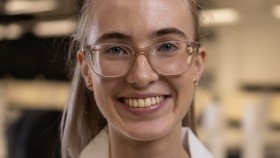Researcher on cloud nine over universe discovery
The mysteries of the evolution of the universe since the Big Bang are one step closer to being solved, thanks to research from The Australian National University.
Astrophysics PhD candidate Mr David Nicholls from the Research School of Astronomy and Astrophysics, part of the ANU College of Physical and Mathematical Sciences, used the ANU 2.3 metre telescope at the Siding Spring Observatory to study distant dwarf galaxies. The galaxies are regarded as ideal ‘laboratories’ for finding out how the Universe has evolved since the Big Bang.
“At the beginning of the Universe, the only elements around were hydrogen and helium. Big stars formed from these elements and, as they evolved, burned the hydrogen and helium into an ‘ash’ of heavier elements. This ash included nitrogen, carbon and oxygen, which are essential for life,” Mr Nicholls said.
“When these big stars ran out of fuel, they blew up in the form of supernovae and mixed the heavier elements back into the hydrogen clouds. New stars grew from the enriched gas. But in Dwarf galaxies, this process has happened very slowly,” he said.
“Dwarf galaxies are the equivalent of historical villages. They still have most of their ‘old buildings’ intact, so we know what they were like when they were first built. On the other hand, in huge cities like Beijing, nearly all the old buildings have been ripped up and you can’t tell what they were like originally – just like larger galaxies.
“By studying dwarf galaxies, we can see what the Universe was like long ago. To do this, we measure the light from the various elements mixed into the hydrogen clouds in the dwarf galaxies, which tells us how enriched they are and how they have evolved since the Universe began.”
But when he started to analyse his measurements, Mr Nicholls discovered that the data didn’t fit the conventional theories. He set out to solve the mystery, and made an unexpected discovery.
“I found that the energies of the electrons in the gas clouds were not distributed the way people had always thought they should be,” he said.
“I used similar measurements of electron energies made by space probes in our Solar System as the basis for a new theory about how gases behave in distant galaxies.
“To my surprise, it explained my data and also solved other problems that had remained unexplained for over 40 years.”
Mr Nicholls said his research will allow more accurate measurements of the elements in distant galaxies and help to explain the evolution of the Universe.














